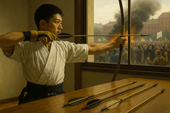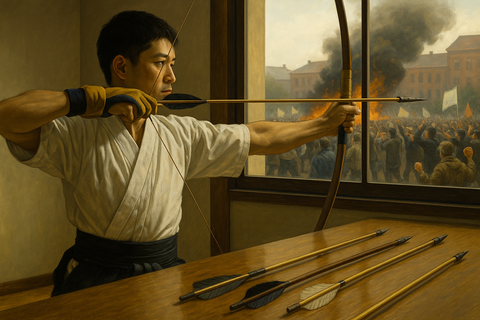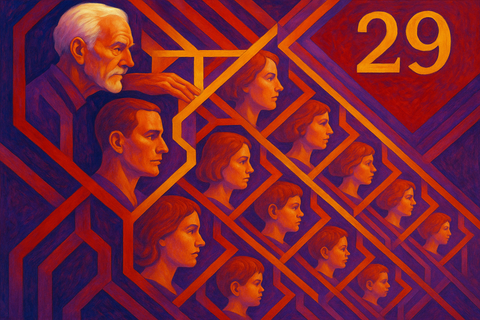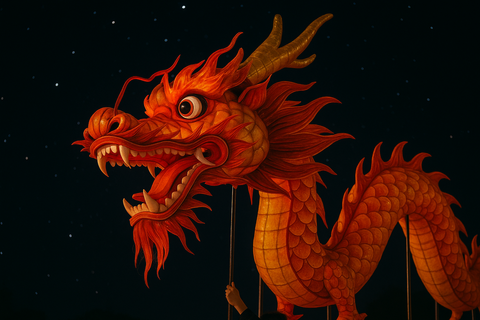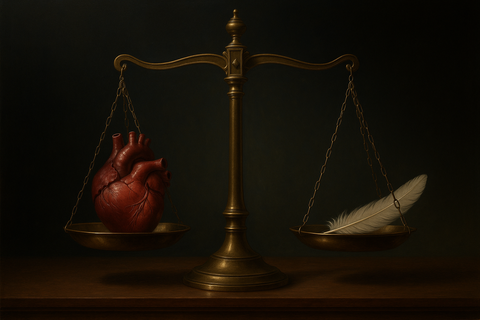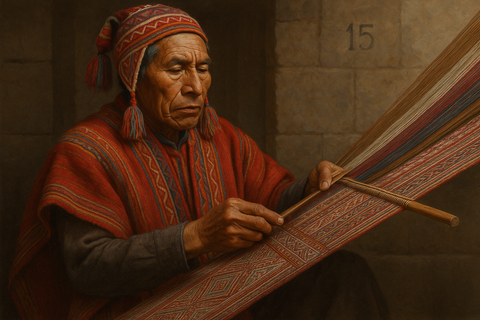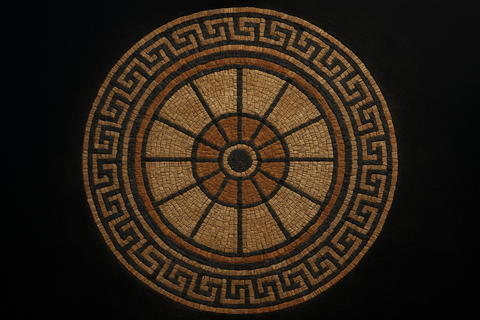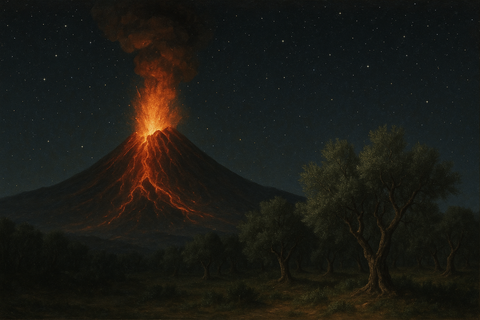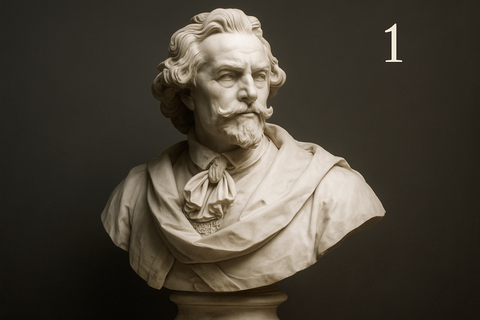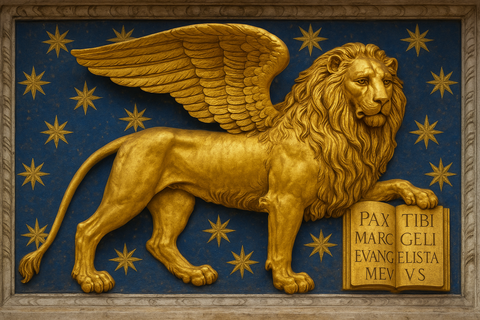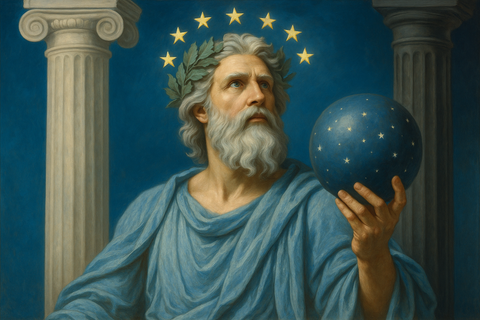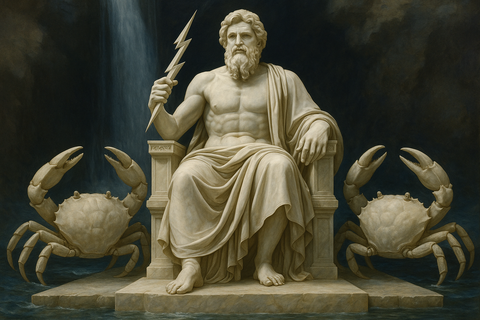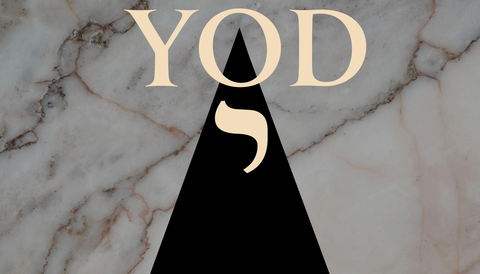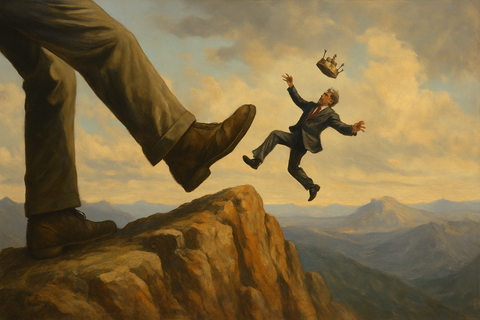And we've reached the eighth installment of this 12-part series exploring the energy of each zodiac sign. Today's post is dedicated to Scorpio . Beyond popular astrology that associates signs with personality, we'll delve into their most essential meaning: their archetypal nature, their symbols, their characteristics, and their manifestation in human experience, both personally and collectively.
What is a Zodiac Sign?
Before discussing Scorpio itself, it's important to clarify the following: when we talk about signs, most people assume we're referring to the personality of those with the Sun in that sign. In reality, this is a huge oversimplification that leaves out many layers of meaning that are valuable to us.
First of all, a zodiac sign is not a person or a personality type . It is a pattern of expression, a way in which a principle manifests . In astrology, principles are represented by planets, asteroids, angles, and any other point on the celestial sphere. Depending on the sign they occupy, their manifestation takes on a specific quality. And that quality is, in essence, an archetype.
What is an Archetype?
An archetype is an essential pattern, an image or energy that recurs throughout history and across different cultures . They are primordial models that structure how we experience reality. In astrology, each sign is an archetype with its own characteristics, an energetic quality that shapes how any astrological principle is expressed.
When a planet is in a sign, the archetype of that sign acts through the planet . The sign doesn't change the planet's essence, but it does determine its style of manifestation. For example, Saturn will behave very differently when it's in Taurus and when it's in Aquarius.
In other words, signs are the way in which a principle takes shape.
Archetypes are Multiple, Eternal, and Inexhaustible
Archetypes are profound and sophisticated realities, with countless nuances and manifestations. They are not static nor limited to a single form of expression ; on the contrary, their richness is so vast that no human being can fully embody the entirety of an archetype in a single lifetime. They are eternal forces that exist beyond our individual experience and express themselves through us in diverse ways according to our consciousness, evolution, and choices.
This is where free will comes into play: (at least consciously) we don't choose which archetypes are present in our birth chart, but we do choose how we experience them. Throughout life, our relationship with an archetype changes . It's not the same to have a planet in Libra at age 8 as it is at age 55. The energy is the same, but the way we understand and express it transforms with experience. We learn to modulate it, to integrate it more consciously, and to use it more constructively.
It follows that all archetypes are neutral. The same sign can be expressed instinctively, chaotically, or unconsciously, or it can be channeled with wisdom and purpose.
We'll come back to the archetypes later. Now let's look at the basics of Scorpio.

A Nocturnal, Water, Fixed Sign, ruled by Mars and Pluto
The name of the zodiac sign Scorpio comes from the Latin word scorpius , which in turn derives from the Greek word skorpíos , meaning "scorpion." This animal has been laden with symbolism since ancient times. In Ancient Egypt, for example, the scorpion was a protective emblem associated with the goddess Serket, guardian of the passages between life and death . It was depicted with its stinger raised, ready to defend and mark boundaries against any threat. In Mesopotamia, scorpion figures also appear as guardians of sacred gates , associated with vigilance during times of transition.
In some Indigenous traditions of the American Southwest, such as among the Hopi and Navajo, the scorpion symbolizes protection from harmful influences and represents a force that remains hidden until action is necessary . This combination of latent danger, defensive capacity, and connection to the thresholds between states—life and death, light and darkness, surface and depth—explains why this animal is associated with processes of intense transformation.
Scorpio is a night sign, also called yin or feminine in traditional classifications. This means its energy is receptive: it gathers, integrates, and preserves. Unlike day signs such as Leo, Libra, and Aquarius, night signs direct their energy inward.
It is also a water sign, the element linked to the emotional world, sensitivity, intuition, and the unconscious. Water has no inherent form, but takes the shape of its container. This is how water signs operate: they perceive the subtle forms of their surroundings, absorb emotional atmospheres, and respond from within rather than from what is visible. Water holds and preserves, but it also erodes over time. Its essential quality is emotional containment. In astrology, this implies resonance, empathy, and a need for psychological security. The water element connects through emotions, not ideas or facts.
On the other hand, the fixed modality comes from the Latin *fixus *, meaning "fixed" or "established." Fixed signs represent the force that gives continuity to the processes initiated by cardinal signs . Fixed signs consolidate; and to do so, they need to resist change and focus on one thing at a time.
On another facet of this energy, Scorpio is a sign with dual rulership ; traditionally ruled by Mars and with Pluto as its modern ruler . In astrology, saying that a planet rules a sign means there is a direct affinity between them. Mars governs willpower, desire, the energy we invest in asserting ourselves in the world , cutting off what threatens our integrity, and facing conflict when it is unavoidable. Mars is Scorpio's ruler because both represent the will to survive ; pure and simple. The will to survive the greatest transformations and losses: the desire to overcome, to go through the extreme and emerge stronger. Here, its strength is not oriented toward external conquest, but toward crystallizing and concentrating life itself amidst the harshest processes . It is the will that resists, that traverses the darkness, and that does not retreat in the face of the irreversible.
The dimension of Mars as the ruler of Scorpio is very different from that manifested in Aries, its daytime domicile. In Aries, Mars acts outwardly: it seeks to conquer something external, to relate to others, to compete, to forge a path. Its impulse is immediate, visible, ignited by contact with the environment. In Scorpio, on the other hand, we are talking about a nocturnal sign: here Mars expresses itself in a much more internal way, driven by a deep emotional content . Action does not arise from an external stimulus, but from an emotional objective experienced as a vital need. In Scorpio, Mars does not fight against another, but with itself. Its battleground is entirely in the intangible: intense emotions, fears, losses, and crises that compel transformation. While in Aries Mars represents the force that initiates and asserts itself externally, in Scorpio it represents the will that persists and traverses what is unseen, to the ultimate consequences.
And finally, Scorpio's modern ruling planet is Pluto . This planet is associated with profound transformation processes, with everything that decays in order to be reborn . Its rulership over Scorpio is understandable because both share a common quality: operating beneath the surface, in what is not readily apparent . Pluto represents the intense forces that drive radical change, the cycles of death and rebirth, the ability to weather a crisis and emerge stronger than before. In Scorpio, this energy translates into a way of life that is unafraid of extremes: feeling deeply, confronting what others avoid, and finding strength in challenging experiences.
(We will delve deeper into these characteristics later.)

The Scorpio Glyph
The glyph (or symbol) of Scorpio is based on the letter “M,” the thirteenth letter in several alphabets, including Latin, English, and Hebrew, where it is called Mem (מ). In Kabbalistic tradition, Mem is associated with the element of water and represents hidden wisdom, silent gestation, and feminine creative power. In the texts of the Sefer Yetzirah—one of the pillars of Kabbalah— Mem symbolizes the primordial womb from which life arises, the flow that unites the visible and the invisible. This connection between water and gestation is maintained in multiple symbolic systems: from the primordial waters of Mesopotamian Tiamat to the “waters of the abyss” of Hebrew tradition.
It is no coincidence that many words associated with internal, cyclical, and transformative processes begin with "M": mother, womb, death, memory, mystery, metamorphosis. All of them refer to what is not immediately visible, but sustains the continuity of life. This subterranean, emotional, and alchemical plane is precisely the territory of Scorpio.
The "M" of Scorpio descends slightly and then ends in an arrow pointing upward and outward, representing the scorpion's sting: the point where contained energy becomes action, defense, or transformation. This arrow is directly related to the glyph of Mars, Scorpio's traditional ruler, and signifies a fundamental principle of this sign: strength does not remain eternally in the shadows, but emerges in a single, precise, and decisive gesture.
Some 19th-century studies of zodiacal symbolism, such as those by Eliphas Lévi and Alan Leo, already emphasized this relationship between the "M" in the glyph and the subterranean and transformative nature of Scorpio. The arrow not only represents a literal sting, but also this sign's ability to pierce the hidden with focused will. In ancient astrological iconography, this shape is also associated with the shedding snake—another figure linked to the underworld, death, and renewal.
The Scorpio glyph, then, synthesizes an entire ancient symbolic structure —water, gestation, transformation, precise action— that spans cultures, alphabets, and traditions.
Scorpio: The Inertia and Darkness of Autumn
In the Northern Hemisphere's agricultural cycle—the symbolic origin of the zodiac we use in astrology—Scorpio marks the midpoint of autumn . The equilibrium of the equinox is gone: the sun descends ever lower on the horizon, the days visibly shorten, and the cold air becomes dominant. No trace remains of the mild, unstable days of Libra. The weather settles into a certain inertia : the sky is gray almost every day, the humidity becomes constant, and the atmosphere adopts a serene and persistent darkness. Nature enters a kind of silence : the birds have migrated, the insects hide, and what was once movement and sound becomes stillness. It is the time when the landscape seems motionless, but beneath the surface, life is reorganizing itself.
In many parts of the Northern Hemisphere, the first frosts begin during the Sun's passage through Scorpio. Water freezes on riverbanks, fallen leaves, and puddles at dawn. The ground, covered by a thick layer of decomposing leaves, exhales a damp, earthy scent. Among this rotting matter—unharvested fruit, seeds that will not germinate, withered stems —earthworms, fungi, and small organisms appear, transforming the dead into food for the coming season. The earth works silently, in a slow and continuous process of decomposition and regeneration.
This is also a crucial point in traditional farming: there is no new planting or expansion. Only the last remaining crops are harvested and processed to survive the winter. Typical fruits of this season include the European medlar , olives , persimmons , pumpkins , and saffron .
The European medlar ( Mespilus germanica ), almost unknown today, had a strong symbolic connection to death and transformation. In many medieval and Renaissance cultures, it was considered the "fruit of winter" because it is not eaten immediately after harvesting: it must begin to rot to become edible . Only when its pulp softens and ferments does it acquire sweetness and flavor.
In medieval Europe, it was known by truly vulgar names like "open-arse" in English or "cul-de-chien" in French, directly referencing its open shape. Writers such as William Shakespeare and Geoffrey Chaucer used it in a mocking tone to talk about desire, decay, and aging bodies. Nothing in this life is a coincidence: in astrological tradition, Scorpio rules the anal region of the body, and the European medlar was for centuries a crude metaphor for that taboo part of the anatomy.

This time of year is when the olive harvest takes place, a practice that remains essential throughout the Mediterranean. Freshly picked olives are inedible: their intensely bitter taste is due to the presence of a compound called oleuropein, a substance the plant produces as a natural defense against insects and fungi. Only through processing is this bitterness transformed. In oil production, the olives are crushed and pressed to separate the oily part from the watery part, where the oleuropein is concentrated. The result is a pure, golden liquid that no longer retains its original bitterness.
Saffron , one of the world's most prized spices, is also harvested during this time. It is extracted with utmost care from the flower of the Crocus sativus . The harvest is brief, meticulous, and silent: each flower must be opened by hand, removing its delicate red stigmas. It is a slow and precise process, quite unlike the expansive abundance of the summer harvest. Saffron, due to its rarity and its power to dye, perfume, and preserve, was once considered an almost magical substance.
During the season when the Sun is in Scorpio, various cultures around the world have developed celebrations dedicated to death , the memory of ancestors, and the transformation of life. The festivities of this period share a common theme: the recognition of the connection between the living and the dead, and the affirmation that death does not interrupt the continuity of existence.
In the Celtic world, Samhain marked the end of the harvest and the beginning of the "dark year." On the night of October 31st, it was believed that the veil between the two worlds—that of the living and that of the dead—thickened, allowing spirits to pass through. To protect themselves and, at the same time, honor them, bonfires were lit, offerings were left, and masks were worn. Over time, as Christianity spread throughout the British Isles, this festival merged with All Hallows ' Eve , which evolved into the modern-day Halloween . From Samhain, it retained its date, the ritual fire, the masks, and the central idea of a night when the world of the dead draws closer to that of the living, although the sacred dimension was replaced by a more playful celebration.
In Mesoamerica , the Day of the Dead has pre-Hispanic roots in the Mexica, Zapotec, and Purépecha cultures, where death was understood as a continuation of the life cycle. At this time of year, it was believed that souls returned to visit their loved ones. The living welcomed them with altars covered in food, candles, copal incense, portraits, and marigolds, whose color and aroma served as a guide for the souls. After colonization, these practices were integrated into the Catholic calendar—November 1st and 2nd—but retained their original meaning: death is not an end, but a return . It is an encounter with ancestors, a dialogue with memory, and an affirmation of the connection with what is no longer physically present.
In Christian Europe , the same date took on a different but complementary character. All Saints' Day (November 1) and All Souls' Day (November 2) became established between the 9th and 10th centuries as days dedicated to praying for the souls in purgatory and visiting cemeteries. In countries like France, Italy, Poland, Hungary, and Croatia, graves are illuminated with candles and covered with chrysanthemums , a flower that blooms at this time of year and, due to its resistance to cold, became an emblem of remembrance and permanence.
Despite the differences between these traditions, they all converge on a single symbolic point: recognizing death as part of the natural cycle and maintaining an active connection with ancestors. While Samhain and the Day of the Dead celebrate the presence of the spirit in the darkness, European Christianity translates it into prayer and light. In all cases, the gesture is the same: affirming that what dies does not disappear, but rather is transformed .
These festivities, born in different geographies and contexts, share a universal intuition that Scorpio embodies with precision: in the darkest time of the year, when nature seems to stand still, life silently reorganizes itself. The boundary between death and rebirth is not a fixed line, but a threshold. And crossing that threshold—with fire, flowers, prayers, or silence—is the symbolic act that defines this phase of the solar cycle.

Saffron harvest in Morocco. Credits: AP
Characteristics of the Scorpio Archetype
So, based on the characteristics of this part of the agricultural year, what traits define this energy in its pure state, before it becomes a personal experience? (Remember that we are not yet talking about people):
1. Balance of opposites
Libran energy tends to seek the right balance between two extremes, regulating what is excessive and compensating for what is lacking. Its function is not to deny difference, but to maintain it in proportion.
2. Oscillation
Balance is never static: to achieve it, Libran energy oscillates between the poles like a pendulum. Harmony arises not from immobility, but from constant movement that adjusts and corrects.
3. Order and moderation
This energy is directed towards order. Moderation eliminates excesses, distributes what is due, and gives each part its place within a common structure.
4. Complementarity
Libran perception is marked by an awareness of pairs: everything is recognized in relation to a complement. Nothing exists in isolation, but rather in coexistence with its other part.
5. Reciprocity
Libra's energy is activated through exchange. It doesn't impose unilaterally, but rather seeks to generate reciprocity: what is one's own is balanced by what is others', what is given returns in another form.
6. Measure and restriction
Libran justice does not depend on personal desire, but on a standard considered superior and impartial. Even if one's own desires must be limited, the just measure prevails over individual inclination.
7. Abstraction
Libra's energy inhabits conceptual planes: justice, proportion, symmetry, harmony. It doesn't need the tangible to operate; it moves in categories that order experience from the abstract.
8. Impersonality
Their perspective tends to dissolve subjectivity in order to achieve a neutral view. Libran energy detaches itself from personal involvement to consider the whole from the outside.
9. Suppression of personal desire
The self is not the center here. Libran energy subordinates individual preference to what is considered fair, balanced, or proportionate, even if it means renouncing one's own inclination.
10. Search for stillness
Libran action is not expressed in unrestrained impulses, but in the regulation that leads to calm. Its tendency is to reduce conflict and generate peace: an energy that discourages excess and leans toward stability.
11. Beauty in proportion
Beauty in Libra doesn't come from the concrete, but from the exact proportion. Diversity finds harmony in balance: the right measure is what reveals beauty.
How These Characteristics Are Expressed in People with Planets in Scorpio
When a person has planets in Scorpio, these archetypal qualities take shape in their life experience. However, how they are integrated and expressed depends on many factors: the level of consciousness, inner work, and the rest of the birth chart . This is where free will comes into play, as Libran energy is not experienced uniformly. Each of its characteristics can manifest constructively or challengingly, depending on how it has been internalized and worked through.
1. Balance of opposites
People with a strong Libran energy tend to gravitate toward extremes to find the middle ground. Instead of defining themselves immediately, they explore different perspectives to understand the entirety of a situation. They may wholeheartedly adopt a stance—for example, a lifestyle or a philosophy—and then, with the same conviction, try its opposite and discover which one feels more coherent.
In group settings, they tend to gravitate toward underrepresented voices: if one position dominates, they naturally tend to align themselves with the other to restore balance. This ability to balance allows them to have a broad and impartial perspective, although in their more challenging role they can become "devil's advocates."
2. Oscillation
Oscillation is the natural way that strongly Libran people achieve harmony: it is a Constant movement between perspectives. These natives usually contemplate scenarios from at least two angles before acting.
In their minds, there is a continuous dialogue between alternatives: "if I do this... but also if I do that... what if..." . They rarely make linear and quick decisions: they need to mentally explore the extremes before settling on the middle ground.
When this oscillation is integrated, it becomes a powerful tool for evaluating options fairly, without haste. But when it becomes disordered, it can transform into paralysis: the person is trapped in an endless back-and-forth that prevents them from moving forward decisively.
3. Order and moderation
People with strong Libran energy tend to seek order, harmony, and proportion in their environment. They are uncomfortable with excess and tend to prefer clean, bright, and balanced spaces—both physically and energetically. Their interactions with others are usually measured: they avoid raising their voices unnecessarily, are mindful of their manners, and moderate their gestures to avoid creating imbalance.
When this quality is expressed maturely, it can result in individuals with a great capacity for creating pleasant environments and stable relationships, where tensions are calmly managed. In its less integrated form, it can appear as an intolerance of chaos or difficulty coping with the unpredictable: they need the world to maintain a certain symmetry to feel internally balanced.
4. Complementarity
Libran perception is permeated by the idea of Coexistence in pairs. People with strongly Libran birth charts easily think in terms of "we" rather than "I." They tend to quickly grasp what the other person needs, adjusting their behavior to create harmony. This can lead to profoundly generous attitudes: they tend to accompany, offer help, and prioritize the common good. But it can also lead them to subordinate their own needs if they haven't developed clear boundaries. Often, they find it easier to balance the other person than to listen to themselves.
In its most mature version, this energy manifests as true cooperation: the self does not disappear, but finds its strength by combining with another part.
5. Reciprocity
They often have a natural ability to see the best in the person in front of them and to combine the strengths of different parts into a common structure. They are very aware of the impact that actions—their own and others'—have on the environment. This principle of reciprocity is deeply linked to a karmic view of the world: what is given, in some way, returns.
At its best, this quality translates into upright conduct, guided by the inner conviction that every action generates an effect that tends toward balance. If they act with integrity, they know they are contributing not only to their own well-being but also to that of the community. But they are also usually quite aware that a selfish or unjust action leaves traces that eventually manifest themselves in the future.
In its most immature form, this awareness can become excessive, generating a fear of making decisions due to fear of the consequences. Or they may expect from others exactly the same reciprocity they offer, and become frustrated if that doesn't happen.
6. Measure and restriction
In Libra, the principle of fair measure is truly a guiding principle in life. People with prominent planets in this sign are often guided by an inner sense of right and wrong that permeates both their personal choices and their relationships. Manners, mannerisms, words, and actions all align with a standard that doesn't depend on their mood, but rather on a higher ideal of justice and proportion.
When this quality is integrated, it generates ethical coherence: these are trustworthy, principled people who don't need to agree with something to recognize what is right. But if this tendency becomes rigid, it can lead to a moralizing stance or difficulty acting spontaneously: they feel they must do "right" even when the situation would require flexibility or a little more healthy self-interest.
7. Abstraction
They tend to have a strongly conceptual mind. They are comfortable operating on mental planes, dealing with ideas such as justice, harmony, proportion, or balance. For them, the intangible—the realm of ideas—can carry more weight than the concrete. This ability allows them to organize complex situations, see structures where others only see fragments, and translate tensions into clearer patterns.
In its highest form, this quality gives rise to individuals capable of understanding the structure behind the immediate, of anticipating consequences, and of giving conceptual form to what others barely intuit.
In its less integrated form, this disconnection from the tangible can lead to a failure to register basic bodily signals (not knowing when they are hungry, tired, or experiencing certain emotions that manifest physically) or to confusing reflection with action. They have great ideas, but these can remain suspended in the mental realm if they are unable to materialize them.
8. Impersonality
One of the defining characteristics of people with strong Libra energy is their ability to distance themselves from personal involvement in order to analyze a situation neutrally. They can fairly assess what is happening, even if it involves someone they love, and speak tactfully yet frankly if something is wrong.
When used in a balanced way, this ability allows for difficult conversations to be conducted without drama, conflicts to be resolved maturely, and a clear and objective perspective to be offered. But in its most problematic expression, it can lead to an overly detached role (or, as in the earlier example of "devil's advocates") even when it's unnecessary. This can make others uncomfortable—especially when someone is seeking emotional support and receives rational analysis instead.
9. Suppression of personal desire
In Libra, The self is not at the center. People with this predominant energy tend to subordinate their personal desires to what they consider fair or necessary to maintain balance. This can lead to a very noble form of altruism: they are not interested in imposing themselves or being the center of attention, but rather in preserving overall harmony.
However, when this quality is not integrated, they can become disconnected from what they want. It's common in these cases that, when asked what they want, they respond with "I don't care" or "whatever you prefer" because they fail to recognize—or forbid themselves from recognizing—their own desires. In the long run, this can translate into low vitality and a loss of enthusiasm, since personal desire is also a source of energy.
When they manage to balance this tendency, they become people who know how to give up without disappearing: they prioritize the common without dissolving into it.
10. Search for stillness
Libran energy seeks peace, stability, and conflict reduction. People with strong Libra elements tend to avoid unnecessary confrontations and act diplomatically. However, paradoxically, this same tendency can generate indirect conflicts: by avoiding uncomfortable conversations or postponing decisions, the problem silently festers.
They can also irritate others when they adopt an overly neutral stance—when the context requires taking sides. At its best, this search for stillness is not avoidance, but an active form of mediation that generates order and calm without denying the existing tension.
11. Beauty in proportion
These people often possess a refined aesthetic sensibility. They don't seek beauty in ostentation, but in precise proportion. This is reflected in their way of dressing, organizing spaces, speaking, and interacting with others. They tend to have innate good taste and instinctively know when something is "in balance."
Practical Examples: Bruce Lee and Björk


Birth chart of Yma Sumac, September 13, 1922, 1:00 PM, Cajamarca, Peru. Rodden Category: AA (birth certificate). Image credit below: Warner Bros.
Yma Sumac was born on September 13, 1922, in Cajamarca, Peru. She was one of the most extraordinary voices of the 20th century , an unmistakable performer who dazzled international audiences with a vocal range spanning more than four octaves and an impeccably precise stage presence. Her emergence onto the music scene in the 1950s coincided with the rise of exotica in the United States. From the release of her album *Voice of the Xtabay* in 1950, she became a cultural phenomenon that transcended borders and stages worldwide. Her birth chart features a powerful stellium in Libra: North Node, Midheaven, Saturn, Mercury, and Jupiter.
In her, Libran energy manifested itself clearly. Oscillation —one of Libra's central qualities—was directly reflected in her voice: she could move fluidly from the low notes of a contralto to crystalline high notes , without losing clarity or musicality. This balance between extremes became her hallmark: it wasn't just a demonstration of technique, it was proportion. Moreover, every melodic curve, every silence, and every accent was measured with a precision that impressed more through its restraint than its volume.
Her work combined diverse repertoires—songs inspired by Andean motifs, stylized lyrical pieces, and orchestral rhythms from the mid-century exotic scene—which she coherently integrated within a single aesthetic framework. It was far from a scattered eclecticism; it was understood as a carefully constructed system of balances. Here, too, Libra's imprint is evident: the ability to maintain unity through difference , to articulate contrasts without losing their form.
Another evident Libran characteristic was her pursuit of beauty in proportion. Yma Sumac meticulously attended to every element of her stage presence: elaborate yet understated costumes, clean lines, and an almost ceremonial bearing . Her image was an organic part of her artistic vision. Everything about her was measured, balanced, and contained within a coherent aesthetic framework. Critics of her time emphasized precisely this impression: she wasn't an overflowing voice, but a controlled phenomenon, a force that unfolded with grace and calculation.
Her persona also reveals a kind of self-suppression in favor of her work . She never positioned herself on stage as a narrator of her personal life or as a confessional protagonist. What she presented was not her biography, but an ideal of beauty and harmony that transcended her. In this sense, her public presence was marked by an elegant, almost impersonal distance, which reinforced her mythical aura and transformed her into a symbol rather than an individual figure.
Thus, Yma Sumac embodied Libran energy through measure, proportion, and formal elegance. Her presence was majestic without being strident, powerful without being intrusive. Her legacy is not only that of an unparalleled voice, but also that of an artist who knew how to transform balance into spectacle.


Björk's birth chart, 21/11/1965, 08:10, Reykjavik, Iceland. Rodden's category: AA (birth certificate). Bottom image credit: GQ
Another notable example of this energy is Serena Williams, born on September 26, 1981, in Saginaw, Michigan. She is one of the most influential figures in tennis history , an athlete who redefined not only the way the game is played, but also how to occupy space in a historically rigid sport. Throughout her career, she has won 23 Grand Slam singles titles—the most in the Open Era—four Olympic medals, and an undisputed place in the history of the sport. Her birth chart features a giant stellium in Libra: the Sun, Saturn, Jupiter, Pluto, and Mercury.
The Libran trait of balancing opposites is evident in his style: he combined immense physical power with a keen reading of the game, aggression with tactical patience, intuition with calculation. He knew when to accelerate and when to brake, when to let the momentum flow and when to hold it back. It wasn't just strength that disarmed his opponents; it was his ability to find the precise moment that would decide the match.
Her presence on the court also reflected the Libran principle of moderation and structure . Serena was known for maintaining her composure even in high-pressure matches. Her technical style—compact shots, measured movement, perfectly calibrated serve—reveals the influence of her Saturn and Jupiter in Libra: control, proportion, and long-term vision . She didn't improvise: she organized the match like a system that could be adjusted and adapted without losing its balance.
Furthermore, her celebrated relationship with her sister Venus embodies another key aspect of this archetype: complementarity. Throughout her career, Venus was not only her closest rival but also her mirror (in fact, they were often referred to and treated as a unit; the Williams sisters ). From the beginning of their careers, the two sisters built a dynamic that broke with traditional competitive paradigms: it wasn't a destructive rivalry, but a balance of complementary forces . In several interviews, Serena has said that Venus was her "greatest inspiration" and not simply an opponent. This way of perceiving competition as a mirror and not as an enemy embodies one of Libra's most refined principles: the coexistence of two poles that mutually strengthen each other .
In another sphere of her life, and very much in the Libran tradition, Serena has been an active voice on issues of racial and gender justice both within and outside of sports. For example, her response to a well-known incident of racism at Indian Wells in 2001 was not confrontational in the classic sense: there was no violence or discursive rupture, but rather a silent yet sustained boycott that lasted 14 years . When she returned in 2015, she did so with a message focused on reconciliation and leading by example. This gesture undoubtedly encapsulates the Libran logic of reciprocity and balance: pointing out injustice, but also leaving open the possibility of restoring harmony. In addition to this, she founded her own investment company. —Serena Ventures— focused on startups led by women and underrepresented minorities, with a discourse focused on “ redistributing opportunities ” and “ balancing power structures ”.
Another aspect where we see the Libran influence is that throughout her career, Serena has maintained a high level of privacy regarding her personal life. Although she is one of the most high-profile athletes in history, she hasn't built her public image on her private life but rather on her work and the causes she champions . Her manner of speaking at press conferences is frequently diplomatic and measured , avoiding personalizing conflicts or displaying excessive emotion. Even in moments of controversy, such as at the 2018 US Open, after a well-known argument with the umpire, she focused her public discourse on the structural inequality faced by women in sports, not on her individual experience. This shift from the personal to a larger idea is profoundly Libran.
In a more concrete sense, Serena also made her mark aesthetically . Her outfits at Wimbledon, the US Open, and other tournaments weren't just fashion choices: it was clear that style was important to her, something she dedicated herself to and cared for. Ballet-inspired dresses, athletic jumpsuits designed for freedom of movement without sacrificing elegance... She never lost her impeccable style, even during the toughest matches.
In short, throughout her career Serena Williams maintained a narrative focused entirely on abstract concepts : legacy, structural change, and paving the way for future generations. Her image wasn't that of an athlete isolated from herself , but rather someone who consistently took the initiative to build bridges and level the playing field, giving visibility to many underrepresented groups at the time (and even today). Her personal drive was gracefully subordinated to a broader vision of justice, representation, and balance . And that's what makes her great both on and off the court.
The Energy of Scorpio at a Collective Level
When Libra's energy is strongly present in the collective, it expresses itself as The capacity for negotiation, regulation, and consensus-building is paramount . It's an environment where positions shift back and forth until a middle ground is reached, where decisions are not made hastily, but rather calmly, through dialogue, and with attention to procedure. Consensus, protocols, established procedures, and the norms that govern coexistence are prioritized. Individual egos take a backseat to shared structures . Harmony and impartiality are paramount.
In the political and social sphere, Libra is linked to the strengthening of institutions, treaties, laws, and multilateral agreements . It is also associated with peace treaties and truces . It is an energy associated with the creation of regulatory frameworks, mediation processes, and arbitration mechanisms. Diplomatic negotiation, deliberative processes, and the construction of common norms that distribute responsibilities among multiple parties are prioritized. Libra marks periods in which societies organize themselves through legal structures and political agreements that seek to preserve balance.
On an economic level, Libra is associated with trade agreements and exchange treaties . Its logic is structured reciprocity: different parties negotiate, agree, and establish clear terms that benefit each of them. Networks of regulated interdependence are prioritized, where the economic flow is sustained through alliances, contracts, and ongoing negotiations.
On a cultural level, Libra appears in cycles marked by beauty, harmony, and order . Sophisticated, refined, and balanced artistic expressions develop, with an emphasis on proportion and elegance. There is also usually special attention to codes of conduct and shared social norms : good manners, etiquette manuals, protocols, and rules that define accepted behavior. Aesthetics are not incidental; they are a structural part of how collective life is organized.
As a cardinal sign, Libra marks the beginning of dynamics of regulation and balance . It seeks to establish shared conditions that integrate multiple poles in a balanced tension; where differences can coexist without destroying each other.


Practical Example: Reissue of Amy Vanderbilt's Complete Book of Etiquette (1978)
On September 6, 1978, with Pluto, Mars, Venus, and the Moon in Libra , a new edition of Amy Vanderbilt's Complete Book of Etiquette , one of the most influential etiquette and manners manuals of the 20th century , was published. Originally published in 1952, this book was not simply a compendium of rules of courtesy: it established a shared language of social behavior that transcended classes, generations, and cultural contexts. Its republication, almost three decades later, responded to a historical moment when American society was undergoing profound transformations and needed to renegotiate its codes of conduct.
In a country emerging from a decade marked by feminist movements, civil struggles, and political tensions, the republication of this manual did not represent a return to the past, but rather the creation of a common framework for interaction . The rules of etiquette functioned here as an invisible structure of harmony: guidelines that facilitated coexistence and the silent negotiation of differences. It was not about imposing one's will, but about establishing agreements .
The republication of this book was not an isolated editorial gesture, but a cultural act that embodied the Libran spirit: the need to agree on forms , to establish proportions and manners that allow differences to coexist within the same framework. In other words, it was a moment when structured beauty and social harmony took center stage, displacing individual urgency in favor of collective coexistence.
Essential Dignities for Scorpio
Essential dignities in astrology are a system that determines the strength and quality of a planet's expression according to the sign it occupies. Each planet has areas where its energy manifests more easily and others where it faces more challenges. There are five main dignities: domicile , when a planet is in its ruling sign and operates naturally; exaltation , where its energy is amplified and expressed in a heightened way; detriment , when it is in the sign opposite its domicile and its expression is weakened or outside its comfort zone; fall , when it is in the sign opposite its exaltation, which can hinder its manifestation; and terms and decans , which are minor dignities that modify the planet's influence at specific degrees of the sign (these will be discussed in future blog posts). This system allows us to interpret how a planet functions in a birth chart according to its zodiacal position.

Mars and Pluto in their Domicile
Scorpio is the first of the zodiac signs with dual rulership (along with Aquarius and Pisces). When we say that Mars is in its domicile in Scorpio, it means that it is in one of the two signs it rules (along with Aries), allowing it to express its energy with strength, precision, and depth. Mars is the planet of will, direct action, the desire to assert oneself, and the drive to overcome obstacles. In Scorpio, these qualities manifest themselves strategically, with restraint and resilience: here, Mars does not act impulsively, but with calculation and an intensity that is hard to match.
Unlike when Mars is in Aries—where it seeks immediate action, movement, and visible conquest—in Scorpio, Martian energy is much more internal. It acts driven by deep emotions and objectives that aren't always openly displayed. This Mars doesn't strike head-on: it waits, calculates, and acts only when it knows there's no turning back. Its force isn't expansive, it's concentrated. It doesn't need to impose itself by shouting; it transforms through silence and precision.
This position grants a great capacity for resilience, maintaining course even in adverse circumstances, and navigating intense processes without becoming disoriented. Mars in Scorpio does not break easily: it grows stronger in times of crisis. However, this same depth can lead to controlling dynamics or confrontations that unfold on more emotional than explicit levels. When Martian energy is not channeled clearly, it can become corrosive or excessively self-demanding.
In terms of essential dignities, Mars in Scorpio has complete control over its astrological function, making it a powerful placement. It favors strategic action, resilience in the face of uncertainty, and the ability to sustain long-term goals. Here, Mars doesn't disperse; it goes to the core. It is the will that does not retreat, that advances silently and transforms from within.
—
♇ Pluto in its Domicile in Scorpio
When Pluto is in its domicile in Scorpio, it signifies that it is in the sign that best expresses its essential nature. Pluto is the planet of radical transformation, the processes of death and rebirth, hidden power, and the ability to transcend extremes. Scorpio shares this same profound pulse, which amplifies its intensity and grants it a very pronounced archetypal force.
Unlike other signs, where Pluto operates more subtly from the shadows, in Scorpio its energy becomes sharp and structural: it emerges clearly, transforming everything it touches at its core. Here, it doesn't settle for superficial adjustments; it seeks total change. Its action is silent, but irreversible.
This position grants enormous transformative power, great emotional resilience, and a unique capacity to sustain through crises. Pluto in Scorpio confronts taboo, pain, and symbolic death without flinching. However, this same force can become destructive when it is not integrated: manipulation, power struggles, or obsessive dynamics can arise if the intensity does not find a conscious outlet.
In terms of essential dignities, Pluto in Scorpio is in its natural element, giving it absolute dominion over its astrological function. It favors processes of profound regeneration, the capacity to sustain great transformations, and to emerge strengthened after experiencing extremes. Here, Pluto does not fear the shadow: it inhabits it, transforms it, and turns it into power.

Venus in Detriment
When we say that Venus is in detriment in Scorpio, it means that it is in the sign opposite one of its natural domiciles—Taurus—forcing it to express itself in an unfamiliar realm. Venus is the planet of harmony, attraction, connections, what we value, and what brings us pleasure. Its natural impulse is to soften, unite, and shape relationships that convey stability and contentment. Scorpio, on the other hand, is a sign linked to emotional intensity, transformative processes, and the need to delve into what others prefer to keep on the surface.
While Venus seeks balance and pleasure, Scorpio confronts her with what is neither simple nor harmonious: extreme desire, unconscious impulses, emotions that cannot be masked with diplomacy. This tension causes desire to not flow lightly, but rather to acquire depth, demandingness, and a high emotional charge. Venus in Scorpio is not satisfied with pleasant relationships: she seeks intensity, absolute devotion, and loyalties that can withstand crises without breaking.
Unlike in Taurus, where Venus enjoys the tangible and stable, in Scorpio it moves in a territory where nothing is certain. What it values is not comfort, but the transformative emotional experience. This can manifest as a very strong need for fusion, which can lead to jealousy, control, or fear of loss. Pleasure ceases to be merely sensory and becomes existential: what attracts is not what is peaceful, but what has real emotional weight.
However, when this placement is integrated, Venus in Scorpio can achieve a unique depth in the realm of relationships. It learns to value intensity without confusing it with possession, and to find beauty in what is raw and true. It can build relationships with unwavering loyalty, where desire doesn't disappear in the face of difficulty, but rather grows stronger through it.
Even so, planets in detriment, when worked with, can yield valuable results. In the case of Venus in Scorpio, attraction and desire take on a more intense and conscious dimension. It can produce people with a great capacity for deep love, sustaining relationships through crises, and finding beauty in what is not perfect, but true. When integrated, this position shows that harmony doesn't always arise from gentleness, but from navigating complexity with emotional openness and genuine commitment.

(Uranus in Exaltation)
Saturn is in exaltation in Libra. This is considered its strongest position, where its energy finds maximum coherence and power . Saturn represents order, structures, limits, and karma. In Libra, these principles are expressed in their most akin to the scales: the balance, the just measure, and the need for rules that preserve harmony.
The symbolism is profound. Libra marks the beginning of the Sun's descent into the dark half of the year, associated in many cultures with the passage to the underworld . In Egypt, psychostasis —the weighing of souls on the scales of Maat—determined fate after death: the heart of the deceased had to be balanced against the feather of truth. This image connects directly with Saturn in Libra: the idea of judgment, responsibility, and consequences . It's not just about external limits, but about the implicit law that governs existence.
In this sign, Saturn teaches that harmony doesn't "just happen," but rather that we create it through respect for rules that guarantee fairness . For justice to exist, a framework of order is necessary. And karma, in its broadest sense, finds its fullest expression here: what goes around comes around , for better or for worse. Saturn in Libra reflects that justice doesn't depend on individual will, but on a universal principle of compensation.
Those who hold this position typically demonstrate a strong sense of responsibility, a clear ethical code, and an impressive awareness of impartiality . They can assume roles of authority with composure and balance, not out of a desire for control, but from an understanding of the order necessary for relationships and society to function. Their greatest strength lies in understanding that nothing goes unanswered: every action has a consequence, and everything tends toward a just balance.

Falling Moon
The Moon is in its fall in Scorpio, and this is considered the most challenging position for this luminary. The fall doesn't imply that the energy is doomed to failure, but rather that it finds itself in unfamiliar territory, requiring deep integration work to unleash its potential. Although many classical astrologers interpret it as a weakened dignity, in practice—when approached consciously—this position can become one of the most powerful, because it compels us to build emotional stability through transformation, not comfort.
Why is the Moon in its fall in Scorpio? Because the Moon represents the need for security, emotional nourishment, and belonging. It seeks to preserve, protect, and give continuity to what already exists. Scorpio, on the other hand, is a sign linked to emotional intensity, shedding, and the processes of death and regeneration. Where the Moon needs firm ground, Scorpio inevitably leads to territories where nothing remains the same. The lunar aspect craves containment; the Scorpionic aspect demands navigating crises. This difference makes Scorpio a profoundly uncomfortable terrain for the Moon.
This imbalance can manifest as intense emotions that struggle to find stability. People with this position tend to feel deeply, but in contexts where trust or security is not guaranteed. This can translate into relationships marked by mistrust, control, or fear of loss. It can also generate a feeling of being unable to relax emotionally, of living in a constant state of internal alertness.
However, when this placement is consciously cultivated, the Moon in Scorpio can attain extraordinary emotional strength. Here, sensitivity is not fragile, but resilient: it learns to sustain itself even amidst uncertainty. It is the Moon that does not crumble in the face of change, but rather transforms with it. This placement can bestow a great capacity for emotional regeneration, accompanying difficult processes, or supporting others in critical moments. The search for security does not disappear, but is redefined: it no longer relies on external stability, but on a deep and unbreakable inner foundation.
The initial challenge—the tension between the lunar need for restraint and Scorpio's transformative intensity—can become a virtue: the ability to find refuge within oneself, to not flee from emotional pain, to navigate crises without dissolving. The Moon in Scorpio teaches that security is not always found in the immutable, but in the strength to be reborn.

Scorpio Mythology:
Libra is associated with Themis , the Greek goddess of divine order. Themis did not represent human laws or the decrees of a ruler, but rather that which was already inscribed in the cosmos before humanity existed. Her name, derived from the Greek themis (“that which is placed, that which is established”), alludes to a justice that is not invented: it is discovered.
Daughter of Uranus and Gaia, Themis belonged to the generation of the Titans . Therefore, her power is older than that of the Olympians: it stems from a natural order that transcends gods and mortals . She was an advisor to Zeus, who could not make momentous decisions without consulting her. On the throne of Olympus, she sat beside him, a principle that reminded the gods that even they were subject to a greater balance.
She was attributed with oracular gifts : before Apollo ruled Delphi, Themis dictated her answers there. Her word was recognized as truth because she saw not only what was shown, but also what lay hidden behind actions. From her sprang deities who embody the very structure of life: the Horae , who regulated the passage of time and the seasons; Dike , the personification of justice; and the Moirai , the Fates who assigned destiny to each human being. Themis was not, therefore, an isolated figure, but the matrix of universal order in all its dimensions.
In the sky, the constellation Libra is unique in that it is represented by an inanimate object : the scales. There is no beast or hero, but an instrument. This is not accidental: in Libra , the central element is not the figure that judges, but the very act of weighing and balancing. The myth of Themis reminds us that true purpose stems from embodying an order that is older than any will.

Topaz and Garnet
The stone associated with Scorpio is topaz . Topaz is an aluminum fluorine nesosilicate, with the chemical formula Al₂SiO₄(F,OH)₂. Its hardness on the Mohs scale is 8, making it a remarkably durable stone. Although it can be found in various shades, the most characteristic for this sign is golden-orange topaz , also called "imperial," whose intense warmth contrasts with the emotional depth that Scorpio represents.
In antiquity, topaz was considered a stone of protection against unseen dangers. The Romans associated it with clarity in the darkness, and in medieval tradition, it was believed to have the power to reveal hidden truths and strengthen the will. In Arabic and European lapidary texts, it was linked to inner fire: a silent force that is not easily extinguished. Its warm transparency, rather than a strident brilliance, reflects the contained and concentrated power that characterizes Scorpio.
On the other hand, the color associated with Scorpio is garnet . This shade is a dark red with earthy and brown undertones, deeper than burgundy. It arises from a combination of red and brown pigments that absorb much of the light, resulting in a dense, opaque, and warm color. Its symbolic resonance is clear: it is the red of blood rather than flowers, the red of life and the underworld.
In various cultures, garnet has been associated with vital force, resilience, and transformation. In medieval heraldry, it represented steadfastness and courage in the face of adversity. In 19th-century fashion and decorative arts, its use conveyed intensity, sobriety, and power. It is not a color of light surfaces, but of depth. It expresses the nature of Scorpio: that which throbs beneath the earth, that which concentrates before emerging, that which transforms without warning.
Keywords Associated with Scorpio:
reptiles - autopsies - Catalonia - butchers - chemistry and chemicals - cemeteries - crematoriums - the dead and everything related to them - dentists - espionage - excrement - genitals - hate - Korea - lava - life after death - menstruation - magic and magicians - New Orleans, Louisiana - surgeries - Norway - sweat - stagnant water - nose - prostate - psychiatrists - anus - reincarnation - research - Liverpool (England) - female and male reproductive system - swamps - urine - sexual relations - decomposition - sarcasm - poisonous plants - first aid - floods - Algeria - tax collectors - crustaceans - geysers - hay fever - mud - Paraguay - legacies - mortgages - spiritual and mental regeneration - sense of smell - stench - Washington DC - underground places - bathrooms (WC) - scorpions - resentment - garbage and waste - reddish and dark colors; undefined - that which is toxic - witches and witchcraft - venereal diseases.


